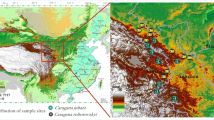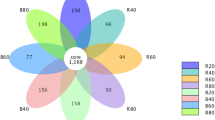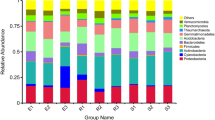Abstract
Aims
The bacterial diversity in rhizosphere soil is closely associated with its environmental factors, such as, pH, moisture and organic contents. The aims of this study were to understand the bacterial diversity in tea plant Camellia sinensis rhizosphere soils and explore its relationship with major organic elements, water, and pH in tea plant rhizosphere soil.
Methods
The tea plant rhizosphere soils were randomly collected from five locations at the south side of Qinling Mountains. The bacterial diversity in the soil was determined by high-throughput amplicon sequencing technology. The organic elements, pH and moisture in the soil were measured using traditional analysis methods. The correlations between bacterial diversity and environmental elements were analyzed by using the General Linear Model (GLM), Canonical Correspondence Analysis (CCA) and Spearman’s rank correlation coefficients methods.
Results
Acidobacteria, Actinobacteria, Bacteroidetes, Chloroflexi, Gemmatimonadetes, Planctomycetes, Proteobacteria and Verrucomicrobia were the dominant phyla in the soil samples. Water content, pH, organic carbon and total nitrogen were the environmental elements that had the greatest correlation with the bacterial diversity in the rhizosphere soil samples. Nitrogen had the greatest effect on the bacterial diversity at genus level. Carbon, potassium, water and pH were positively correlated with Pedobacter and Mucilaginibacter genera.
Conclusions
The bacterial diversity in tea plant rhizosphere is closely associated with its environmental elements. The soil elements in tea plant rhizosphere could also be adjusted through the change of rhizobacteria diversity besides chemical fertilization.








Similar content being viewed by others
References
Adrain JM, Westrop SR, Chatterton DEB, Ramskild L (2000) Silurian trilobite alpha diversity and the end-Ordovician mass extinction. Paleobiology 26:625–646 https://www.jstor.org/stable/2666103
Aguirre-von-Wobeser E, Rocha-Estrada J, Shapiro LR, de la Torre M (2018) Enrichment of Verrucomicrobia, Actinobacteria and Burkholderiales drives selection of bacterial community from soil by maize roots in a traditional milpa agroecosystem. PLoS One 13(12):e0208852. https://doi.org/10.1371/journal.pone.0208852
Bao S (2000) Agro-chemical analyses of soils. China Agriculture Press, Beijing
Baudoin E, Benizri E, Guckert A (2003) Impact of artificial root exudates on the bacterial community structure in bulk soil and maize rhizosphere. Soil Biol Biochem 35(9):1183–1192. https://doi.org/10.1016/S0038-0717(03)00179-2
Berlanas C, Berbegal M, Elena G, Laidani M, Cibriain JF, Sagües A, Gramaje D (2019) The fungal and bacterial Rhizosphere microbiome associated with grapevine rootstock genotypes in mature and young vineyards. Front Microbiol 10:1142. https://doi.org/10.3389/fmicb.2019.01142
Chao A (1984) Non-parametric estimation of the number of classes in a population. Scand J Stat 11(4):265–270 https://www.jstor.org/stable/4615964
Chen ZM, Lin Z (2015) Tea and human health:biomedical functions of tea active components and current issues. J Zhejiang Univ Sci B 16(2):87–102. https://doi.org/10.1631/jzus.B1500001
Chen L, Li C, Feng Q, Wei Y, Zheng H, Zhao Y, Feng Y, Li H (2017) Shifts in soil microbial metabolic activities and community structures along a salinity gradient of irrigation water in a typical arid region of China. Sci. Total Environ 598:64–70. https://doi.org/10.1016/j.scitotenv.2017.04.105
Colwell RK, Coddington JA (1994) Estimating terrestrial biodiversity through extrapolation. Philos Trans R Soc Lond Ser B Biol Sci 345:101–118. https://doi.org/10.1098/rstb.1994.0091
Dennis PG, Miller AJ, Hirsch PR (2010) Are root exudates more important than other sources of rhizodeposits in structuring rhizosphere bacterial communities? FEMS Microbiol Ecol 72(3):313–327. https://doi.org/10.1111/j.1574-6941.2010.00860.x
Egner H, Riehm H, Domingo WR (1960) Untersuchungen über die chemische Bodenanalyse als Grundlage für die Beurteilung des Nährstoffzustandes der Böden: II. Chemische extraktionsmethoden zur Phosphorund Kaliumbestimmung. Kungl Lantbrukshögskolans Annaler 26:46–61
Finkel OM, Castrillo G, Paredes SH, González IS, Dangl JL (2017) Understanding and exploiting plant beneficial microbes. Curr Opin Plant Biol 38:155–163. https://doi.org/10.1016/j.pbi.2017.04.018
Fu D, Yang H, Wang L, Yang S, Li R, Zhang W, Ai X, Ai Y (2018) Vegetation and soil nutrient restoration of cut slopes using outside soil spray seeding in the plateau region of southwestern China. J Environ Manag 228:47–54. https://doi.org/10.1016/j.jenvman.2018.08.108
Fujii Y, Akihiro F, Syuntro H (2004) Rhizosphere soil method: a new bioassay to evaluate allelopathy in the field. 3rd Australian New Zealand soils conference: novel approaches. Charles Sturt University press, Australia, pp 490–492
García-Salamanca A, Molina-Henares MA, Van-Dillewijn P, Solano S, Pizarro-Tobías P, Roca A, Duque E, Ramos JL (2012) Bacterial diversity in the rhizosphere of maize and the surrounding carbonate-rich bulk soil. Microb Biotechnol 6:36–44. https://doi.org/10.1111/j.1751-7915.2012.00358.x
Garcia-Sánchez M, Garcia-Romera I, Cajthaml T, Tlustoš P, Száková J (2015) Changes in soil microbial community functionality and structure in a metal-polluted site: the effect of digestate and fly ash applications. J Environ Manag 162:63–73. https://doi.org/10.1016/j.jenvman.2015.07.042
Garrett LG, Beets PN, Clinton PW, Smaill SJ (2019) National series of long-term intensive harvesting trials in Pinus radiata stands in New Zealand: initial biomass, carbon and nutrient pool data. Data Brief 27:104757. https://doi.org/10.1016/j.dib.2019.104757
Greenlon A, Chang PL, Damtew ZM, Muleta A, Carrasquilla-Garcia N, Kim D, Nguyen HP, Suryawanshi V, Krieg CP, Yadav SK, Patel JS, Mukherjee A, Udupa S, Benjelloun I, Thami-Alami I, Yasin M, Patil B, Singh S, Sarma BK, EJB V-W, Kahraman A, Bukun B, Assefa F, Tesfaye K, Fikre A, Cook DR (2019) Global-level population genomics reveals differential effects of geography and phylogeny on horizontal gene transfer in soil bacteria. Proc Natl Acad Sci U S A 116(30):15200–15209. https://doi.org/10.1073/pnas.1900056116
Guo A, Ding L, Tang Z, Zhao Z, Duan G (2019) Microbial response to CaCO3 application in an acid soil in southern China. J Environ Sci (China) 79:321–329. https://doi.org/10.1016/j.jes.2018.12.007
Ikeda S, Sasaki K, Okubo T, Yamashita A, Terasawa K, Bao Z, Liu D, Watanabe T, Murase J, Asakawa S, Eda S, Mitsui H, Sato T, Minamisawa K (2014) Low nitrogen fertilization adapts rice root microbiome to low nutrient environment by changing biogeochemical functions. Microbes Environ 29(1):50–59. https://doi.org/10.1264/jsme2.me13110
Khalifa AYZ, AlMalki M (2019) Polyphasic characterization of Delftia acidovorans ESM-1, a facultative methylotrophic bacterium isolated from rhizosphere of Eruca sativa. Saudi J Biol Sci 26(6):1262–1267. https://doi.org/10.1016/j.sjbs.2018.05.015
Khan MU, Li P, Amjad H, Khan AQ, Arafat Y, Waqas M, Li Z, Noman A, Islam W, Wu L, Zhang Z, Lin W (2019) Exploring the potential of overexpressed OsCIPK2 Rice as a nitrogen utilization efficient crop and analysis of its associated Rhizo-compartmental microbial communities. Int J Mol Sci 20(15):E3636. https://doi.org/10.3390/ijms20153636
Lukhele T, Selvarajan R, Nyoni H, Mamba BB, Msagati TAM (2019) Diversity and functional profile of bacterial communities at Lancaster acid mine drainage dam, South Africa as revealed by 16S rRNA gene high-throughput sequencing analysis. Extremophiles 23:719–734. https://doi.org/10.1007/s00792-019-01130-7
Ma S, De-Frenne P, Boon N, Brunet J, Cousins SAO, Decocq G, Kolb A, Lemke I, Liira J, Naaf T, Orczewska A, Plue J, Wulf M, Verheyen K (2019) Plant species identity and soil characteristics determine rhizosphere soil bacteria community composition in European temperate forests. FEMS Microbiol Ecol 95(6):fiz063. https://doi.org/10.1093/femsec/fiz063
O'Brien FJM, Almaraz M, Foster MA, Hill AF, Huber DP, King EK, Langford H, Lowe MA, Mickan BS, Miller VS, Moore OW, Mathes F, Gleeson D, Leopold M (2019) Soil salinity and pH drive soil bacterial community composition and diversity along a lateritic slope in the Avon River critical zone observatory, Western Australia. Front Microbiol 10:1486. https://doi.org/10.3389/fmicb.2019.01486
Pasternak Z, Al-Ashhab A, Gatica J, Gafny R, Avraham S, Minz D, Gillor O, Jurkevitch E (2013) Spatial and temporal biogeography of soil microbial communities in arid and semiarid regions. PLoS One 8(7):e69705. https://doi.org/10.1371/journal.pone.0069705
Rao M, Steinbauer MJ, Xiang X, Zhang M, Mi X, Zhang J, Ma K, Svenning JC (2018) Environmental and evolutionary drivers of diversity patterns in the tea family (Theaceae s. s.) across China. Ecol Evol 8(23):11663–11676. https://doi.org/10.1002/ece3.4619
Rupp H, Meissner R, Leinweber P (2018) Plant available phosphorus in soil as predictor for the leaching potential: insights from long-term lysimeter studies. Ambio 47(Suppl 1):103–113. https://doi.org/10.1007/s13280-017-0975-x
Schmidt R, Gravuer K, Bossange AV, Mitchell J, Scow K (2018) Long-term use of cover crops and no-till shift soil microbial community life strategies in agricultural soil. PLoS One 13(2):e0192953. https://doi.org/10.1371/journal.pone.0192953
Shang J, Liu B (2020) Application of a microbial consortium improves the growth of Camellia sinensis and influences the indigenous rhizosphere bacterial communities. J Appl Microbiol Online ahead of print https://doi.org/10.1111/jam.14927
Stutter MI, Richards S (2012) Relationships between soil physicochemical, microbiological properties, and nutrient release in buffer soils compared to field soils. J Environ Qual 41(2):400–409. https://doi.org/10.2134/jeq2010.0456
Tu LH, Chen G, Peng Y, Hu HL, Hu TX, Zhang J, Li XW, Liu L, Tang Y (2014) Soil biochemical responses to nitrogen addition in a bamboo forest. PLoS One 9(7):e102315. https://doi.org/10.1371/journal.pone.0102315
Wang L, Li ZY, Liu RR, Li LL, Wang WW (2019a) Bacterial diversity in soybean Rhizosphere soil at seedling and mature stages. Pol J Microbiol 68(2):281–284. https://doi.org/10.33073/pjm-2019-023
Wang M, Deng B, Fu X, Sun H, Xu Z (2019b) Characterizations of microbial diversity and machine oil degrading microbes in machine oil contaminated soil. Environ Pollut 255(Pt 1):113190. https://doi.org/10.1016/j.envpol.2019.113190
Wang Y, Liu L, Yue F, Li D (2019c) Dynamics of carbon and nitrogen storage in two typical plantation ecosystems of different stand ages on the loess plateau of China. PeerJ 7(11):e7708. https://doi.org/10.7717/peerj.7708
Xing KX, Zhao MF, Chen C, Wang YH, Xue F, Zhang YP, Dong XB, Jiang Y, Chen H, Kang M (2018) Leaf phosphorus content of Quercus wutaishanica increases with total soil potassium in the loess plateau. PLoS One 13(8):e0201350. https://doi.org/10.1371/journal.pone.0201350
Yu K, Chen X, Pan G, Zhang X, Chen C (2016) Dynamics of soil available phosphorus and its impact factors under simulated climate change in typical farmland of Taihu Lake region, China. Environ Monit Assess 188(2):88. https://doi.org/10.1007/s10661-015-5087-0
Zhang X, Zhang R, Gao J, Wang X, Fan F, Ma X, Yin H, Zhang C, Feng K, Deng Y (2017) Thirty-one years of rice-rice-green manure rotations shape the rhizosphere microbial community and enrich beneficial bacteria. Soil Biol Biochem 104:208–217. https://doi.org/10.1016/j.soilbio.2016.10.023
Zhang MM, YB WN, Sun GY (2018) Changes in soil physicochemical properties and soil bacterial community in mulberry (Morus alba L.)/alfalfa (Medicago sativa L.) intercropping system. Microbiologyopen 7(2):e00555. https://doi.org/10.1002/mbo3.555
Zi HY, Jiang YL, Cheng XM, Li WT, Huang XX (2020) Change of rhizospheric bacterial community of the ancient wild tea along elevational gradients in Ailao mountain, China. Sci Rep 10(1):9203. https://doi.org/10.1038/s41598-020-66173-9
Acknowledgments
This study was funded by the Foundation of Education Department of Shaanxi Province for Special Project (19JK0191), the Foundation of Shaanxi University of Technology (SLG1809), and Young Scientist Empowerment Project of Shaanxi Association of Science and Technology (20200206).
Author information
Authors and Affiliations
Corresponding author
Additional information
Responsible Editor: Yongguan Zhu
Publisher’s note
Springer Nature remains neutral with regard to jurisdictional claims in published maps and institutional affiliations.
Rights and permissions
About this article
Cite this article
Wang, M., Sun, H., Xu, L. et al. Bacterial diversity in tea plant (Camellia sinensis) rhizosphere soil from Qinling Mountains and its relationship with environmental elements. Plant Soil 460, 403–415 (2021). https://doi.org/10.1007/s11104-020-04822-8
Received:
Accepted:
Published:
Issue Date:
DOI: https://doi.org/10.1007/s11104-020-04822-8




